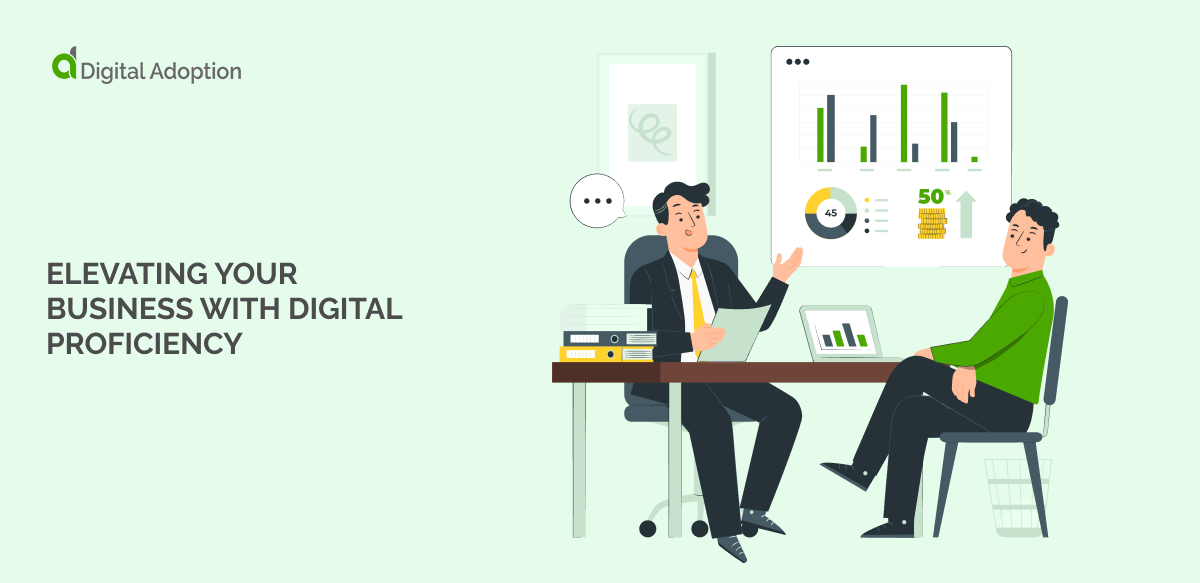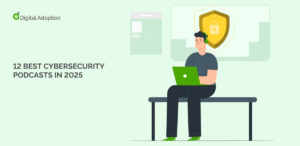Digital proficiency is effectively using digital tools, platforms, and strategies in various tasks and functions.
It’s about more than just knowing how to use these tools.
Instead, digital proficiency means understanding the potential and implications of digital tools, optimizing their use for productivity and innovation, and integrating them naturally into daily operations.
The digital age has rapidly transformed the way businesses operate. Technology plays a pivotal role everywhere you look, from communication tools to advanced analytics.
You’re probably no stranger to these changes. You’ve seen firsthand how the business landscape grows more digital by the day.
Mckinsey found in 2021 that those with higher digital proficiency were 41% more likely to earn a top-quintile income than those with lower digital proficiency. This finding strongly suggests that employees with digital proficiency are more valuable to businesses.
And that makes perfect sense. If you’re driving digital adoption, you want your employees to be effective with new tools as quickly as possible.
So, what does it mean to be truly adept in a digital environment?
That’s the core of what we’re talking about in this article. We will unpack what digital proficiency is, why you need to understand it, and how to boost it within your organization.
Understanding digital proficiency
The digital corporate world is full of jargon, and it’s common to encounter terms that seem interchangeable but have distinct meanings.
Let’s clarify the difference between digital literacy, digital fluency, and digital proficiency, so you can better gauge where you and your organization stand.
Digital literacy
At its core, digital literacy is about having the basic skills to navigate the digital world.
It’s like knowing the alphabet of the digital language.
You can use specific tools or software and understand their rudimentary functions if you’re digitally literate.
Digital fluency
This is the next step up. Being digitally fluent means you don’t just use digital tools; you’re adept at them.
It’s similar to forming full sentences and having conversations in the digital language.
You can manipulate tools, experiment with their functionalities, and even innovate using them.
Digital proficiency
This is where you aim for your employees to be.
It’s not just about using or mastering digital tools. It’s about weaving them seamlessly into your business processes, optimizing each operation, and spotting opportunities to leverage technology.
Imagine being an eloquent orator or author in the digital language, where you’re not just communicating but captivating and innovating.
4 key elements of digital proficiency
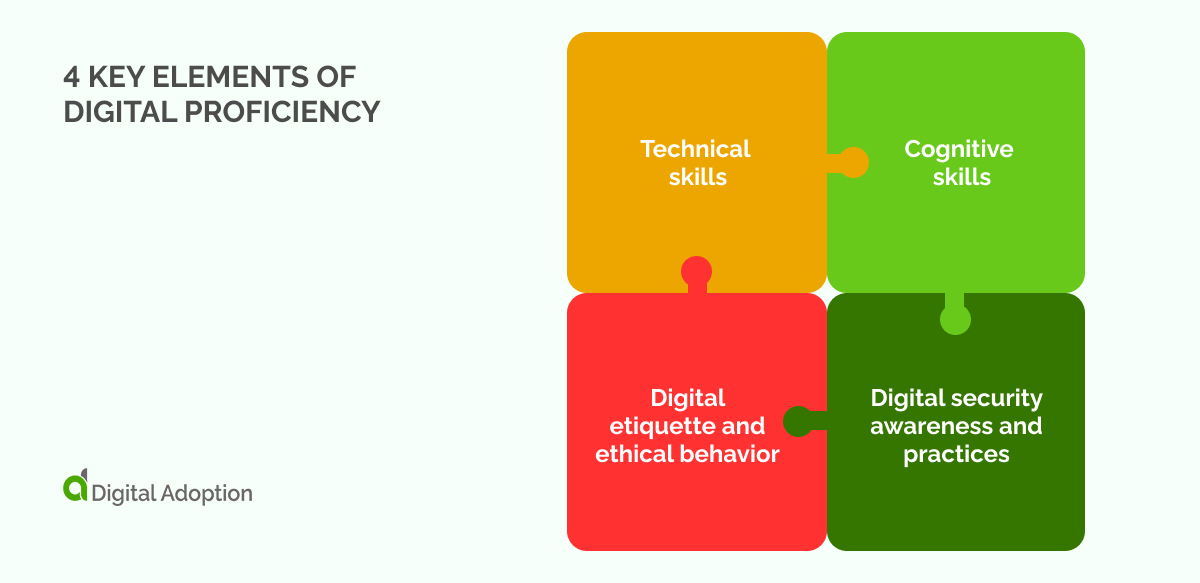
Digital proficiency is more than just being tech-savvy.
It’s about strategically integrating digital elements into your business model, ensuring you’re poised for growth, agility, and security in an increasingly digital age.
Let’s delve into what constitutes digital proficiency:
1. Technical skills
You need to understand the software, platforms, and devices at your disposal.
It’s like having a well-equipped toolbox and knowing exactly which tool to use for a particular task.
2. Cognitive skills
Beyond the tools, you need to grasp the larger digital landscape.
Can you identify credible online sources? Are you aware of emerging digital trends that could reshape your industry?
These skills ensure you’re making informed, strategic decisions in the digital domain.
3. Digital etiquette and ethical behavior
In the digital space, your behavior reflects on your business.
Recognize the unspoken rules of digital interactions, respect digital boundaries, and ensure your actions align with the highest ethical standards.
4. Digital security awareness and practices
Cyber threats loom large.
Being proficient means safeguarding your digital assets.
Understand the vulnerabilities, stay updated on potential threats, and adopt stringent digital security practices to protect your business and clientele.
8 reasons why digital proficiency matters
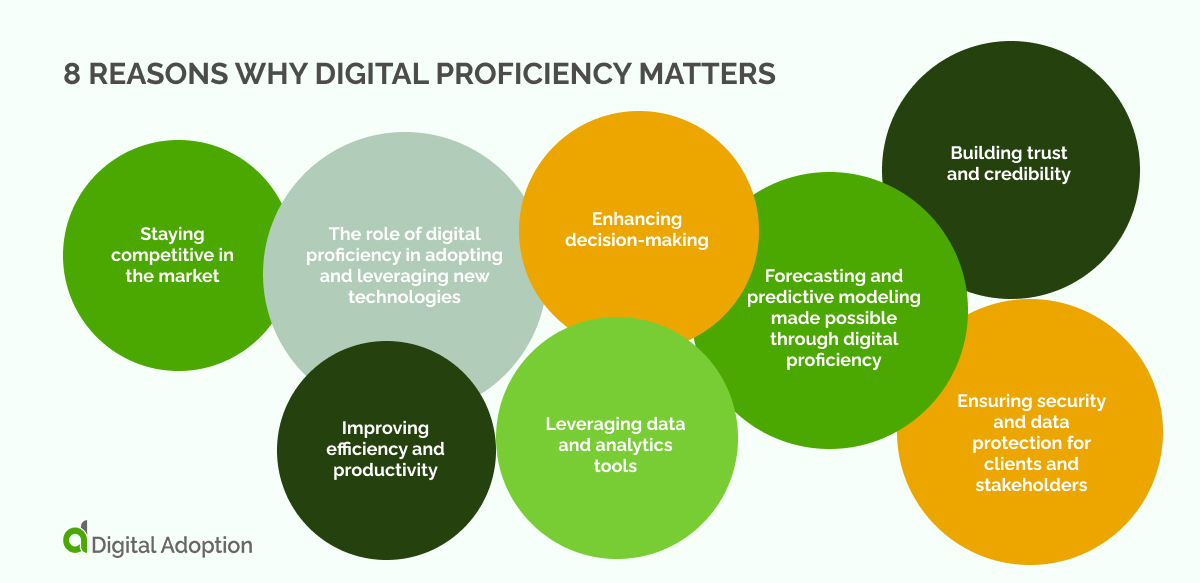
Nowadays, your ability to stay ahead hinges on more than just offering a great product or service.
It’s about how agile, informed, and adaptive you are in the face of technological evolution.
Here are 8 reasons why digital proficiency is paramount for you as a business leader:
1. Staying competitive in the market
In a world where the latest software or digital strategy can revolutionize an industry overnight, being proficient ensures you’re not playing catch-up.
It empowers you to stay on the cutting edge, differentiating your business from competitors.
2. The role of digital proficiency in adopting and leveraging new technologies
New technologies can either be overwhelming or transformative.
With digital proficiency, you can discern which technologies align with your business goals, ensuring you invest time and resources wisely.
Your digital transformation efforts will be proactive, not reactive.
3. Improving efficiency and productivity:
With the right digital tools and the proficiency to use them optimally, tasks that once took hours can be reduced to minutes.
Boosting employee productivity is about doing more with less, ensuring your team spends time on strategy and innovation rather than manual processes.
4. Enhancing decision-making:
Gone are the days of relying solely on instinct.
With digital proficiency, you can harness data and analytics tools to make informed decisions.
It helps you ground your strategies in tangible insights.
5. Leveraging data and analytics tools:
Data is the new gold.
But it’s worthless if you don’t know how to mine and refine it.
Digital proficiency equips you to draw actionable insights from vast pools of data, allowing you to understand your market and clientele like never before.
6. Forecasting and predictive modeling made possible through digital proficiency:
Imagine being able to predict market shifts or customer behavior.
With advanced tools and the ability to wield them, you can foresee trends and strategically position your business.
7. Building trust and credibility:
In a digital-first world, customers gauge your credibility by your digital presence and prowess.
An outdated website or a clunky app can erode trust.
Digital proficiency ensures you present a polished, modern image to your clients.
8. Ensuring security and data protection for clients and stakeholders:
Security breaches can spell disaster, not just financially but reputationally.
Digital proficiency isn’t just about leveraging tools; it’s about safeguarding sensitive data, ensuring you protect your business’s most valuable asset: its reputation.
Developing digital proficiency within your business: A 5-step journey
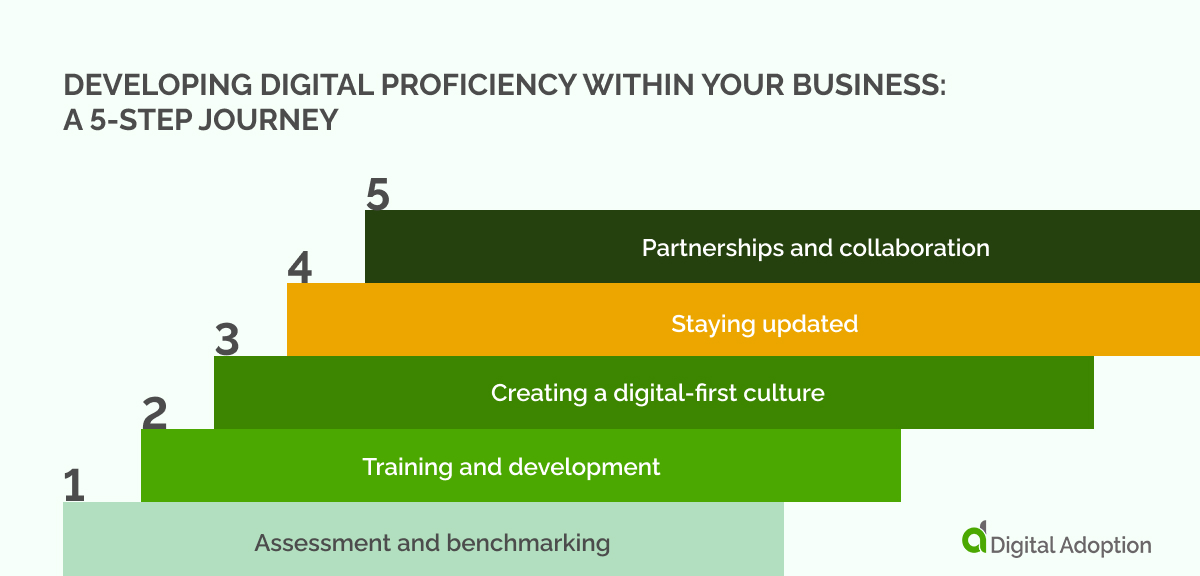
Digital proficiency can be hard to come by in employees.
According to Eurostat, only 54% of working-age people in the EU had at least basic overall digital skills in 2021– that’s nearly half of the working population who don’t even achieve digital literacy, let alone digital proficiency.
How do you cultivate digital proficiency within your organization?
We’ve created a 5-step guide to help you along. Just remember:
Incorporating digital proficiency into your business model is an ongoing journey, not a one-off project.
Also, the onus is on you as a leader to pave the path, ensuring each step solidifies your digital footing.
Let’s walk through the stages to make this transformative journey successful:
Step 1: Assessment and benchmarking:
Evaluating the current state of digital proficiency: Before charting out the roadmap, take stock of where you stand.
Assess the current digital skills of your team, the tools in use, and areas of improvement.
Tools and metrics to measure proficiency: Utilize digital assessment tools and KPIs to gauge proficiency levels.
Metrics could range from software proficiency scores to digital project completion rates.
Step 2: Training and development:
Investing in continuous learning and development programs: Static knowledge is obsolete knowledge.
Encourage and fund continuous learning opportunities for your team.
Highlighting successful training platforms and programs suited for businesses: Platforms like Coursera, LinkedIn Learning, and Udemy offer courses tailored for businesses.
Identify courses that align with your goals and encourage participation.
Step 3: Creating a digital-first culture:
Promoting a mindset shift among employees: Shift the narrative.
Make sure your team knows that digital isn’t just a tool, but a core aspect of your business strategy.
Offering incentives for employees to adopt and utilize digital tools effectively: Rewards and recognitions can drive behavior.
Recognize employees who exemplify digital proficiency or bring innovative digital solutions.
Step 4: Staying updated:
Subscribing to digital news, updates, and best practices: Knowledge is power.
Ensure you and your team are always informed about the latest in the digital world.
Encouraging participation in digital forums, webinars, and conferences: These platforms offer real-world insights, networking opportunities, and a pulse on the industry’s direction.
Step 5: Partnerships and collaboration:
Aligning with digital leaders and influencers in the industry: Build relationships with those at the forefront of the digital realm.
Their insights can guide your strategy and help avoid potential pitfalls.
Engaging with technology firms for hands-on training and workshops: Theory is good; practice is better.
Collaborative workshops can give your team practical experience and confidence in applying their digital skills.
4 common pitfalls to avoid
While the journey to digital proficiency offers numerous rewards, it’s laden with potential pitfalls.
Navigating the digital proficiency path requires a blend of foresight, adaptability, and vigilance.
By being aware of these pitfalls, you can make informed decisions, ensuring a smoother transition for your business into the digital age.
Here’s a closer look:
Overlooking the human element and focusing solely on technology:
It’s easy to get mesmerized by the latest software or gadget.
However, technology is only as good as the people using it.
Remember to invest in your team, foster a supportive environment, and ensure they’re comfortable and competent with the tools available.
Not updating training materials or processes:
The digital realm is dynamic, and what’s relevant today may be outdated tomorrow.
Ensure that your employee training materials are periodically reviewed and updated.
Sticking to old protocols can hinder growth and lead to inefficiencies.
Resistance to change among staff and leadership:
Change can be daunting, and it’s natural for some to resist.
It’s essential to understand the root of this resistance, whether it’s fear of the unknown or attachment to old methods.
Address concerns head-on, involve your team in decision-making, and emphasize the long-term benefits of this shift.
Underestimating security threats:
Security can sometimes take a back seat in the rush to adopt digital tools and processes.
However, breaches can be costly financially and in terms of reputation.
Stay informed about the latest threats, invest in robust security measures, and ensure your team is well-versed in best practices to protect sensitive data.
Digital proficiency: The air beneath your wings
In the kaleidoscope of modern business dynamics, digital proficiency isn’t just another color; it’s the very spectrum allowing us to perceive and interact with the vibrant opportunities around us.
It’s clear to us, and hopefully to you, that embracing and nurturing digital proficiency is imperative for survival and success in this ever-evolving landscape.
But understanding its importance is just the first step.
The real journey begins when you decide to take proactive measures.
To embed digital proficiency within your organization’s DNA.
To uplift, train, and inspire your team.
To leverage tools not as crutches but as catalysts.
And most importantly, to remain adaptable, ensuring that as the digital tide rises, your business doesn’t just float but soars.

